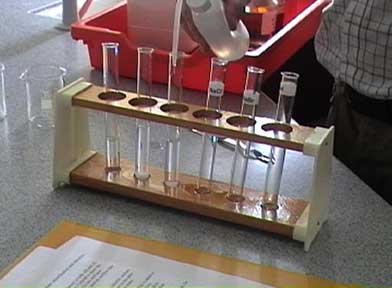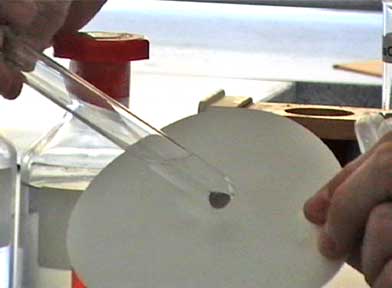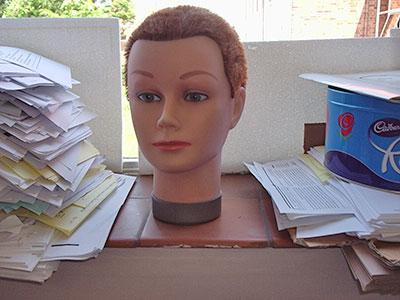June 21st, 2006
- BBC Podcast of Melvyn Bragg’s “In Our Time” radio program for 15th June: The subject was Carbon and among the contributors was Harry Kroto
- This year’s George Simonyi lecture was also given by Kroto. He has an unusual lecturing style. Kieran McCarthy recorded and journalised the proceedings. The lecture was about the Internet and associated changes; as well as the need for science and objectivity.
- A colleague has the following anecdote about Kroto: The eminent chemist made a model from card of a possible structure of the C60 molecule. The model blew off the table and fell to the floor and bounced. The fact that the structure remained intact, and showed elasticity, convinced Kroto that he was on the right lines.
Posted in Notes | Comments Off
June 20th, 2006
“It was a good point. Bill Gates was amazingly technical. He understood Variants, and COM objects, and IDispatch and why Automation is different than vtables and why this might lead to dual interfaces. He worried about date functions. He didn’t meddle in software if he trusted the people who were working on it, but you couldn’t bullshit him for a minute because he was a programmer. A real, actual, programmer.”
Joel Spolsky’s Joel on Software has the essay from which I took the quote and Jeff Jarvis has reposted his Guardian essay on BuzzMachine.
Posted in Notes | Comments Off
June 19th, 2006
Seth Goldin recently changed to Nisus (coup for them). If you deal with pure words, I guess the interface is the main feature and it is a fine piece of work. Two small companies allow me to download trial versions compare products for a feature that is important to me. Support forums are available online that enable me to check how responsive (or not) the company is to a feature request. As a consequence, I am an informed customer, and one less likely to gripe afterwards.
I’m using an iBook G4 at home as my main computer. Word 2004 is slooooow sluggish and treacle like on this machine. I’ve been looking at a lightweight word-processor for some time. The competition comes down to
Nisus wins on interface and the way you can have draft view and page view at different scales. Alas, it looses on mathematical formulas and diagrams. Formulas made with the
LaTeX Equation Editor are printed as bitmaps by Nisus. This issue was
raised on the support forum in October 2004 and there has apparently been no movement since, and that indicates that Nisus is aimed at people who do words and not diagrams. Mellel is not as intuitive an interface to my current way of thinking, but the package will accept
PDF formulas and print and save them smoothly to
PDF and
RTF.
Technorati Tags: technology
Posted in Notes | No Comments »
June 15th, 2006

The still above was sampled from a DV camera recording of a chemical demonstration by the irrepressible (incompressible?) Dave C . The still is reduced in size by 50% from the iMovie video capture – the frames come in at 784 by 576 pixels on the particular JVC DV camera we were using. iMovie and Windows Movie Maker both make it possible to grab frames as stills, and this facility could help produce MS PowerPoints for flash slide shows of lab procedures so students can see what things look like. A short PowerPoint showing visuals of the steps might be useful especially for evening class students who usually only get one attempt at practicals.
Sound is basic from the video camera; I had the Olympus digital voice recorder and an external microphone set up to catch the commentary as well and the quality is much better with the separate recorder. I’m planning on editing the video clips to the sound track as a guide so that the small clips I sampled from the DV camera will provide a visual demonstration of the points in the commentary. I did two takes, one with a wide frame and a second with zooms onto the test tubes and reagents. Cross cutting and some stills to cover the transitions will handle it.
When importing the clips into iMovie from the DV camera, I sampled short sections of about 10 to 30 seconds to give as much leeway as possible when editing. This is almost ‘editing in camera’ and I may need to resample from the DV tape to get the best clips. I find iMovie easier to use than Windows Movie Maker on a good spec XP laptop. I need to know both so time will tell. The iMovie project file comes in at 3.7 Gigabytes so I’m glad of the external hard drive.
Videos of classic demonstrations will be useful for evening and weekend students who miss the actual event, and for review and revision.

The image above shows how the Silver Chloride precipitate clears when exposed to sunlight – the grey deposit at the bottom of the test tube is silver. This reaction is close to my heart as it is the basis of photography.
Technorati Tags: elearning, technology
Posted in ILT | Comments Off
June 11th, 2006

Download a podcast explaining what a virtual learning environment does, and how a VLE adds value over a blog or static Web page for supporting students between lessons. This podcast represents part of my attempt to ‘pitch’ the use of a virtual learning environment to colleagues who may not have seen or used one before. I’m trying to make clear the extra value that a VLE such as Moodle can provide over the simple class blog.
I’m trying to set up a series of stepping stones in online support, teachers can start with a class blog and try that for a term or a year. If they like the results – if the cost benefit ratio is good for the teacher and the target group – then Moodle might be next; or it might turn out that the class blog is ‘good enough’ and represents the optimum support for that target group. The relationship between a class blog and a VLE ‘course’ for that group needs exploring to prevent confusing students (and teachers).
The podcast lasts just over 4 minutes. It was recorded on the WS-200S digital voice recorder using an external dynamic microphone, and, yes, I do live near a scrambling and go-cart track.
I had to edit the recording. When my tongue decided to get tangled I just repeated the paragraph after a few seconds and used the delete function in Audacity to remove the fluffed paragraph. Leaving a few seconds made it easier to locate the offending passage visually on the Audacity timeline. The track was exported as an MP3 at a data rate of 48 Kb/sec, I found that exporting at 32 Kb/sec gave a slight clanger feel to the recording.
The script will appear ‘below the fold’ later. The image is totally gratuitous – just struck me as an odd thing to see – and it is here mainly to amuse David.
Technorati Tags: elearning, podcasting, teaching
Read the rest of this entry »
Posted in ILT, Podcasts | Comments Off
June 11th, 2006
A guitar and a simple equation: f = sqrt(T/p) / 2L was all he needed.
He differentiated it and demonstrated the change in frequency if we adjusted the length (L), tension (T) and density (p) of the guitar strings. The sheer simplicity in the demonstration would make students fall in love with calculus. To borrow from mathematician lingo, it was straight out of the book!
I shall keep this idea in the back of my mind for the Rate of Change topic that is coming into the
GCSE Higher syllabus in 2007.
From Sucre’s blog about being a trainee teacher somewhere in Singapore. There is no information about the author so I suppose this is a personal blog for friends. The front page for today, June 11th tells me that Sucre completed the training and is now looking forward to teaching in a school. I can certainly remember my first year of teaching full-time!
Technorati Tags: maths teaching
Posted in Maths | Comments Off
June 6th, 2006
According to debriefs from students, the following topics were not seen on the AQA paper
- Constructions
- Pythagoras
- Trigonometry
So I guess these are racing certainties for the Calculator paper. Keep revising!
Posted in Maths | Comments Off


